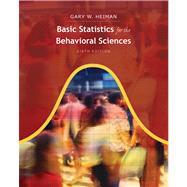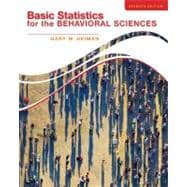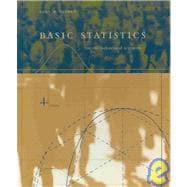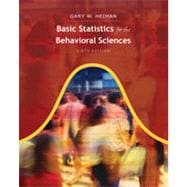Basic Statistics for the Behavioral Sciences

Basic Statistics for the Behavioral Sciences
- ISBN 13:
9780618528134
- ISBN 10:
061852813X
- Edition: 5th
- Format: Hardcover
- Copyright: 07/08/2005
- Publisher: Wadsworth Publishing
- Newer Edition
Rent
Sorry, this item is currently unavailable.
Note: Supplemental materials are not guaranteed with Rental or Used book purchases.
Extend or Purchase Your Rental at Any Time
Need to keep your rental past your due date? At any time before your due date you can extend or purchase your rental through your account.
Summary
Basic Statistics for the Behavioral Sciencesdemystifies and fully explains statistics without leaving out relevant topics or simply presenting formulas, in a format that is non-threatening and inviting to students. Gary Heiman has written a textbook--clearly, patiently, and with an occasional touch of humor--that teaches students not onlyhowto compute an answer on demand, but alsowhythey should perform the procedure or what their answer reveals about the data. Heiman has achieved five objectives in writing this text: to take a conceptual-intuitive approach, to present statistics within an understandable research context, to deal directly and positively with student weaknesses in mathematics, to introduce new terms and concepts in an integrated way, and to create a text that students will enjoy as well as learn from! New!Chapter 1 has been significantly revised to make it more student friendly and current. New!Appendix B explains the basics of how to use SPSS to analyze data. Tips on using SPSS are integrated throughout the text and now have a specific index to guide students. New! A Quick Reviewfeature from Heiman'sEssentialstext has been added to this edition. Each contains a simple review of previous concepts, additional examples, and study questions. New!A new section on Statistics in Published Research has been added to help students gain a perspective on how researchers use statistics and relates what students have learned in the chapter to what they will see (and won't see) when reading published research. (Includes using the APA format for stats.) Getting Startedsection at the beginning of each chapter lists previously discussed concepts that students should review, followed by the learning goals for the chapter. New! Statistical Notationsections introduce statistical notations at the beginning of relevant chapters in which they are needed. For added clarity, statistical notations are introduced separately from the conceptual issues presented in the chapter. Remembercallout sections provide added reinforcement by reviewing the calculation or interpretation of a statistic and emphasizing each procedural point. Computation formulas are labeled and highlighted in color throughout the text. Putting It All Togethersections at the end of each chapter provide advice, cautions, and ways to integrate material from different chapters. Chapter Summaryprovides a substantive review of the material, not merely a list of the topics covered. Summary of Formulasat the end of each chapter serves as a quick reference. Reference tables in the front endpages provide guidelines for selecting from the descriptive and inferential procedures discussed in the text based on the type of data or research design employed. References to "psychology" have been reduced so that the text pertains to other behavioral sciences as well. An engaging, non-threatening writing style and step-by-step conceptual approach support math-anxious students. Reduced repetitiveness, wordiness, and protracted explanations in this extensive revision have streamlined the narrative, without sacrificing content or comprehension. Conceptual presentations have been tightened and a number of new explanatory techniques have been added. Throughout, greater emphasis is placed on explaining how to use statistics and how to "think" in statistical terms Pedagogically effective use of examples includes in nearly all examples specific variables and research questions instead of generic data. Many early examples are taken from everyday life, so that students have an intuitive feel for the meaning of the scores and relationships discussed. In later chapters, examples become more technical and "psychological." The text provides clear explan











